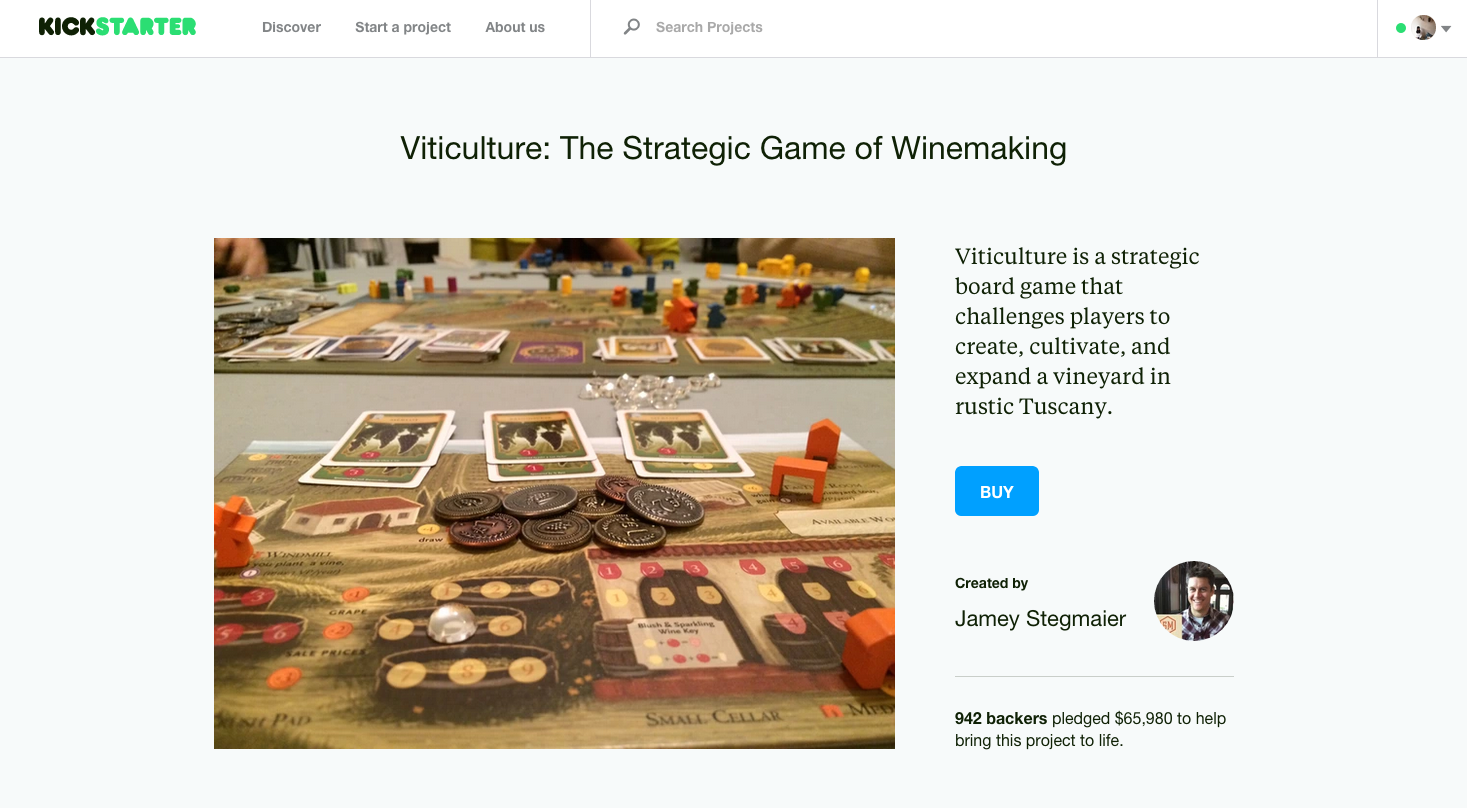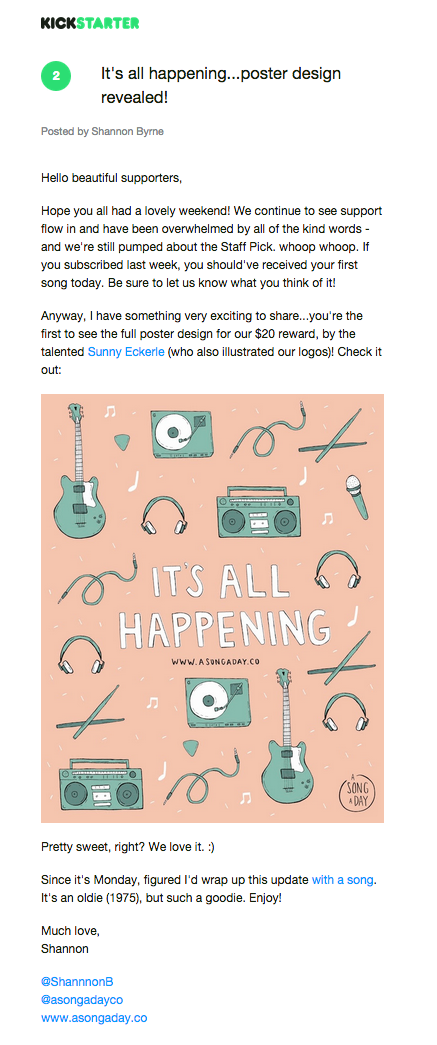Email Best Practices
4 email hacks to launch a successful Kickstarter campaign
Get the most out of your Kickstarter campaign by implementing a pre-launch and update strategy, including email and influencer marketing.

PUBLISHED ON
The grand total of $55K funded one entrepreneur’s Potato Salad Kickstarter – a monumental 31,576% above his goal. Exploding Kittens, a card game for people who “are into kittens and explosions and laser beams”, designed by the creators of The Oatmeal, became Kickstarter’s most backed campaign in history, with 219K supporters altogether.
We’ve all heard the success stories, but with the staggering statistic that 60% of all Kickstarter campaigns fail, what sets a good campaign from a great one that receives funding several times over?
It’s a complicated answer that includes a mixture of timing and marketing groundwork that is highly dependent on your product and audience, but we can tell you one thing: behind every successful Kickstarter launch is a solid email marketing strategy.
In this article, we’ll go through several tips to give your funding a boost and convert backers into long-term influencers well after the campaign ends.
Before we do, begin by building a Kickstarter page with quality imagery and an engaging elevator pitch. That’s half the battle of getting you into the coveted status of one of Kickstarter’s featured campaigns. On average, crowdfunding projects featured by Kickstarter see a bump of 150% of their goal the next day.
Table of contents
1. Raise awareness before your Kickstarter campaign starts
2. Show gratitude to your email subscribers during the Kickstarter campaign
3. Reward your Kickstarter backers with special content
4. Keep your Kickstarter backers in the loop
Hacks to boost your funding and convert backers
Before creating a Kickstarter page, entrepreneurs often create a pre-launch strategy to entice friends, family, and influencers to back the campaign. A pre-launch strategy includes these three hacks to boost funding and convert backers: awareness, gratitude, and rewards. Why? Well, it’s also important to keep your backers in the loop.
1. Raise awareness before your Kickstarter campaign starts
Launching a crowdfunding campaign is hard work, and it takes courage to put your idea out there.
Start building up anticipation in the weeks leading up to your Kickstarter launch. Your email marketing strategy should include creating an email list of your existing community, friends, and family to get them excited. You can do this by giving them a sneak peek of rewards or a teaser of your Kickstarter video. This will help build traction so that you’ll already have influencers, comments, and engagement on the day you officially launch. Social proof can be a powerful thing. After all, seeing that others have vouched for an idea proves the project is worth its investment.
Then, on the launch day, follow up with an email to share your Kickstarter page along with your call-to-action (CTA) and ways your community can support.
A Song A Day, which sends personalized song recommendations from a community of curators, nailed it with this announcement email below. They started off the note addressing users by name, combined with a personal “thank you” from the founder. This personalization complements the text-only format really well.
They also go on to bullet point ways users can help support the campaign by backing the campaign, sharing a tweet, or emailing to music-loving friends and family.

2. Show gratitude to your email subscribers during the Kickstarter campaign
It never hurts for entrepreneurs to give their backers a shout-out to remind them how much their support is appreciated. When Snap Judgment, a weekly radio show and podcast, raised over their original funding goal, they thanked their backers by sending a team selfie. In addition to that, they unlocked a few special rewards to treat their supporters.

Founder of winemaking game Viticulture, Jamey Stegmaier, took time to thank each and every one of his 942 backers within 24 hours of their pledge. Stegmaier said, “I have to say, I never regretted sending one of those messages… I got some great feedback that shaped the Viticulture campaign in a positive way, and I laid a foundation of communication that paid off down the road with many people.”
Stegmaier pre-built templates to make his digital marketing initiative easier to do. Using the templates, he customized bits about the backer after scanning their profile. Stegmaier also shared that conversations with his backers provided insights into where his project could be further clarified or improved. This is a great reminder to always think of backers as individuals, not in terms of numbers or the greater funding goal.

3. Reward your Kickstarter backers with special content
Another way to boost your Kickstarter’s success is by embedding videos and GIFs in your project updates. Try switching things up with your text-only emails by throwing in visual content every now and then. After all, as the saying goes, a picture’s worth a thousand words. As part of UNHCR and Kickstarter’s recent partnership, an outreach campaign to support refugee crisis relief work, they sent out this email with a powerful, moving video and message as a last call for donations.

Be mindful though, not all email clients support special media elements. As a workaround, we recommend including a screen grab of a scene from your video with a play button over top, then linking it to a landing page where your video will automatically play. After all, the goal is for your fans to click back to your Kickstarter page.
Another way to treat your backers with exclusive content is by revealing part of a reward that’s still unavailable to the general public. A Song A Day gave their backers a pleasant surprise one Monday morning by releasing their full poster design (their $20 reward) and a special tune, too.

4. Keep your Kickstarter backers in the loop
Make sure your backers and influencers stay engaged with regular project update emails. Striking a chord with your audience is key because it gives you the opportunity to remind them why they funded this project in the first place and of the goal you’re moving toward. Make them laugh, make them nostalgic, make them cry. Remember, your backers are very much your co-creators of the project – what or where would you be without them? They’re undeniably an integral part of your product launch. Nurturing that connection will motivate your influencers to share your content in Facebook groups and other social media forums. And to bank off tip three, this, in turn, will make it all the more likely for it to catch the attention of Kickstarter and wind up making its way to be featured as a Project We Love.
Other things to consider before launching a Kickstarter page
The old adage, “build it and they will come” doesn’t work when launching a new product via crowdfunding. But first, you need to entice backers to pre-order and convince them to support your project. After all, no one wants to back a project that is doomed to fail because of lack of planning.
Not only will proper planning give your project its best chances of success, it also gives your project the best chances of being selected as (you guessed it!) a Kickstarter Project We Love. Kickstarter awards its Project We Love badge to projects that are well-crafted and express your vision in a clear, concise, and attention-grabbing way. Consider these steps during your pre-launch strategy sessions:
Create a coherent project line to set the stage from beginning to end for your product: The more detailed you are, the more you’ll be able to show and tell the story of your project to backers and influencers.
Create a detailed budget: Your budget needs to be realistic to avoid the pitfalls of an underfunded project. Be as detailed as possible when explaining the amount you’re requesting on your Kickstarter page.
Update the landing page regularly: Begin by creating a pre-launch landing page to spread the news. Then update it often. Tell the story of your project in a thoughtful and authentic way as it takes a life of its own.
Share the campaign pre-launch to gain a wider perspective: Spread the news in every way you can think of to attract influencers. This includes using email marketing and social media. Learn from people who support your idea. Pitch your project to the press. Invite people to try it for free. Now’s not the time to be secretive or overprotective, share your ideas and ask for feedback.
Get context by studying successful campaigns: Imitation is the best form of flattery, and often, it’s also the best way to succeed. Study what works and doesn’t work for other Kickstarter launches. For example:
The Potato Salad Kickstarter used a simple approach to attract backers, with videos and updates to keep their audience informed. The campaign turned out to be hugely successful.
Exploding Kittens is a card game that raised $9M to bring the project to life. The campaign created a story using images to show the progression from inception as well as how to play the game, using a light-hearted tone reminiscent of game night.
Mistakes to avoid when launching a Kickstarter campaign
One of the biggest mistakes entrepreneurs make when launching a Kickstarter page is improper planning. To be successful, avoid these common mistakes – they could literally cost you thousands of dollars…or more.
Fly-by-night planning: Your project will not succeed with overnight planning. Your pre-launch strategy needs to be comprehensive and include email marketing, social media, and more. Not only will proper planning set your campaign up for success, but it will also give your project the best chance of being selected by Kickstarter for the Project We Love badge.
Only-interesting-to-you ideas: Most concepts are created to fill a need. But that doesn’t mean that all ideas are suited for large audiences. Let’s face it, if you’re the OCD type, using a stick to straighten items out of place on your bookcase while seated at your desk may not appeal to everyone. On the other hand, a vacuum that works while you sleep is arguably something most people want, right? Use product demos to judge your product’s appeal. It’s also a great way to create a following by collecting email addresses of potential backers and influencers.
Vague goals: Clearly identifying what you want to achieve gives your backers confidence to invest in your product. Use the SMART acronym to create goals that are specific, measurable, achievable, relatable, and time-bound. Remember, one of the considerations Kickstarter uses to determine a fit for a Product We Love is a clear plan for completing the project. SMART goals will help define that.
Social media shyness. Not everyone is social savvy, but that’s OK. Leaving social media out of the equation, however, is not. Here’s where influencers can play a huge role in helping get your product off the ground. Reach out to big names on Twitter, Instagram, and TikTok, and offer to share your product and campaign with them in exchange for a mention or plug on their feed.
Wrapping up
And there you have it! As you’re preparing for your Kickstarter launch, remember to dedicate time to thinking about your email marketing and optimization strategy. We’ve seen it can drive valuable feedback that helps you adjust your copy, overall marketing strategy, or even your product. We’ve seen email’s role in spreading the word on social media. It’s a channel that can’t be ignored when crowdfunding. It’s the key to building community. Let these free templates inspire you.
Are you looking for more marketing ideas to boost your Kickstarter project? Join our newsletter and learn how email can help you!








